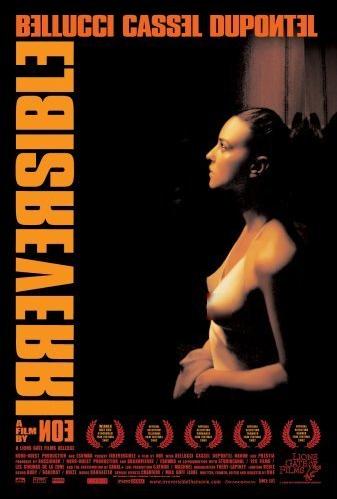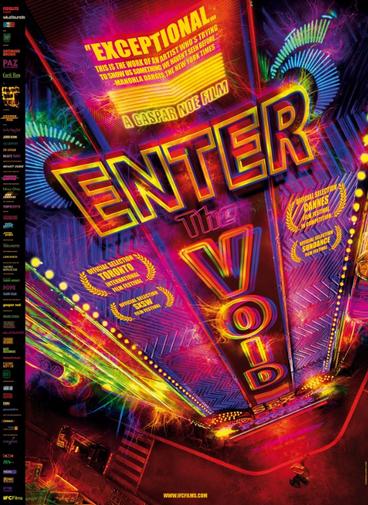The Film Vault is a monthly feature designed to showcase critically-acclaimed films that had limited commercial release and/or success. Each feature highlights films that focus on a specific theme, genre, or technique designed to provide a greater understanding of film as an entertainment and art form.
One of the marquees of a great director is their ability to imprint themselves, or at least their own style, on their films. Running down a list of expert directors, you can immediately conjure images that are manifestations of those individuals. Ridley Scott, Steven Spielberg, Alfred Hitchcock; the list goes on. I dare you to read each of those names and not to immediately receive a mental image that defines their work.
This installment of the Film Vault is focused on Gaspar Noé. He has largely fallen under the radar as a director due to the art-house style and graphic nature of his films. Nothing he has created can be defined as an “easy watch.” Another reviewer described Noé’s films as “hating his actors, but hating his audience more.” That is an understatement. He choice of projects fall on the far edge of acceptable storylines and are coupled with brutality makes watching his work more of an exercise in willpower than enjoyment at times.
Despite this, there is honesty and ethereal approach to his film making that is nearly impossible to find anywhere else. His style is so unique that you will want to watch his work just to see what he will do next. If nothing else, the viewer can appreciate that Noé bends the traditional structure of film to display reality–as opposed to the façade of reality that is typical in Hollywood productions. Or in his words, “when reality is portrayed it’s so sentimental and cheaply humanist that you are disgusted, like a cake with too much sugar.” The question for the audience is not whether you want cake, but rather how do you want it.

IRREVERSIBLE (2002)
Director: Gaspar Noé
Trailer: http://www.youtube.com/watch?v=OU-ZOHeWLkU
Playing backwards in the style of “Momento,” Noé explores the antagonism between morality and human existence. Using the real life romance of French stars Vincent Cassel (“Read My Lips”) and Monica Bellucci (“Malena”) as a springboard, “Irreversible” casts the two as posh Parisian lovers whose lives are about to be turned upside down.
Events over the course of one traumatic night in Paris unfold in reverse-chronological order as (in order) the beautiful Alex is brutally raped and beaten by a stranger in the underpass. Her boyfriend and ex-lover take matters into their own hands by hiring two criminals to help them find the rapist so that they can exact revenge. A simultaneously beautiful and terrible examination of the destructive nature of cause and effect, and how time destroys everything. (Written by Denny Gibbons)
When the film premiered at Cannes, the sheer brutality of certain scenes were reported to cause audience members to faint, throw up, or walk out. Whether that is the truth or a clever marketing device is only as debatable as your own reaction. Noé himself said, “I think people walk out not because they are bored but because they can’t take it… I walked out once during a rape scene in a movie, which came in the middle because I said, ‘Well if this is the middle of the movie, I don’t want to see what happens next.’ I suppose in my movie a lot of people suspect that the end of my movie is going to be worse than the beginning because that’s how the climax of the movie works. The fact is if they stay they will get something that will erase these first images.”
Words to keep in mind, as “Irreversible” has one of the most intense rape scenes on film. Clocking in at an uncut eight minutes, Noé puts the camera on the ground and has his actors improvise the dialogue and action. In Noé’s words, “There were no dialogues written at all. I could not describe the rape. She gets raped and when the man finishes she tries to escape and then he starts beating her and kicking her face. That’s the way it was written. I would say that scene was more directed by Monica than by me.” To call it brutal and unflinching does not begin to describe it. It will linger in your conscience for days and will change the way you see violence on screen.
As if that wasn’t enough, Noé is best known for combining pornographic elements into traditional film. While not as sexually charged as “Enter the Void,” the audience should be prepared. Chronologically following the rape, the revenge scene is staged inside a gay S&M club. Noé was so concerned about being labeled homophobic for combining the extreme violence with the backdrop of the club that he put himself in the film as one of the club patrons. Several shots as the camera careens through the club press the audience’s tolerance for moral behavior.
What stands apart from the violence and sexuality is Noé’s unique approach to film-making. The entire film is composed of only 12 long scenes. Transitions between scenes are accomplished using long floating shots through the sets. The audience careens through the scenes as if they were ghosts. The atmospheric effect this adds to the storyline entrenches the audience in the events: you become less of a watcher and more of a participant. The choice of having the plot play out in reverse chronological order not only changes the tone of the film, but the audience’s response. Placing the worst violence at the beginning makes you think about it during the course of the preceding events. When you see Monica later in the film, you don’t view her as an object of desire as much as a vulnerable woman marching towards the inevitable. Flipping the script induces the audience to examine the morality of the tale, if only in a structured sense.
Acting 3.75
Character 3.25
Structure 3.75
Writing 3.50
OVERALL 3.50

ENTER THE VOID (2009)
Director: Gaspar Noé
Trailer: http://www.youtube.com/watch?v=JJkPLYmUyzg
Prior to directing any films, the inspiration for “Enter the Void” came from Noé watching “Lady in the Lake” under the influence of psychedelic mushrooms. One part story, one part pornography, one part philosophical spiritualism, and one part insane drug-induced trip, the film cannot be easily interpreted or dismissed.
The story is based loosely on the Tibetan Book of the Dead, which is briefly noted in the narrative. Filmed largely from the point of view of protagonist Oscar (Nathaniel Brown), including most of the early scenes following him from behind. The beginning of the film serves to set up the philosophical wanderings as Oscar is shown going about a typical day, introducing his close relationship with his stripper sister and his usage of hallucinogenic DMT. During a drug deal turned wrong, Oscar is shot and killed. Enter act two, where his soul separates from his body and we follow it into the night.
Details of Oscar and his sister’s early life are brought forward, including the family tragedy that explains part of their bond. Continuing onward, his soul returns to the mortal plane to observe how the world is going along without him. Returning is Noé’s flying camera work as the spirit travels all over Tokyo in simulated continuous scenes. At the finally, Oscar’s spirit returns to his sister’s body where it is implied that he is reborn.
With all that going on, it is surprising that the film does not have much plot or narrative. Most of the film is extended lucid camera shots and trippy hallucinations. The vibe of the film, a basement rave or strip club, lends to the camera work. Heavy muffled techno beats are the soundtrack coupled with saturated kaleidoscope visuals.
The simulated drug trip will be a major detraction for most audiences. While not a linear approach to film, the technical achievement and sheer aesthetics of what is created demands a certain respect for the art. As with “Irreversible,” the film’s style places the audience in the film. By the end, the film is something that happened to you as oppose to something you watched.
Noé’s theme again is our basest urges and he plays off it in disturbing fashion. The rampant sex, especially during the hotel scene borders extremely close to pornography. The hallmark violence is also present, this time in the form of a graphic abortion scene. The combination of the sacred and the profane is hard to watch, yet irresistible at the same time. That combination takes a masterful hand to control – something that Noé has proven he has.
Acting 3.25
Character 3.00
Structure 3.75
Writing 3.50
OVERALL 3.25
Theatrical Releases This Week
Cowboys and Aliens
Director: Jon Favreau
A stranger with no memory of his past stumbles into the hard desert town of Absolution in 1873 Arizona. The only hint to his history is a mysterious shackle that encircles one wrist. What he discovers is that the people of Absolution don’t welcome strangers, and nobody makes a move on its streets unless ordered to do so by the iron-fisted Colonel Dolarhyde. It’s a town that lives in fear. But Absolution is about to experience fear it can scarcely comprehend, as the desolate city is attacked by marauders from the sky.
Coming up just behind that Potter kid is one of the most hotly anticipated movies of this summer, a film that is generating some early positive press – both from Variety and The Hollywood Reporter. Seems that Favreau manages to blend his Spielberg-trained storytelling with the classic B-movies he’s trying to rip off.
Crazy, Stupid, Love
Directors: Glenn Ficarra, John Requa
Cal and Emily have the perfect life together living the American dream until Emily asks for a divorce. Now Cal has to navigate the single scene with a little help from his professional bachelor friend Jacob Palmer.
A mixed bag of reviews. Most negative comments content that there is too much sitcom humor and too many subplots. On the positive side, the actors portrayal of the characters especially early in the film is highly regarded. Look for my review on The Dagger this Friday.
The Smurfs
Director: Raja Gosnell
When the evil wizard Gargamel chases the tiny blue Smurfs out of their village, they tumble from their magical world and into ours — in fact, smack dab in the middle of Central Park. Just three apples high and stuck in the Big Apple, the Smurfs must find a way to get back to their village before Gargamel tracks them down.
Good God, this looks awful. Besides crapping all over my childhood, this flick is being helmed by the man who brought us “Beverly Hills Chihuahua” and “Big Momma’s House.” The only saving grace might be Neil Patrick Harris, but I’m not holding my breath.
DVD Releases This Week
Source Code
Director: Duncan Jones
An action thriller centered on a soldier who wakes up in the body of an unknown man and discovers he’s part of a mission to find the bomber of a Chicago commuter train.
Previously reviewed on The Dagger.



In my opinion Gaspar Noé is a genius of modern cinema. his concept of portraying visual art as a way of building tension in film is incredibly unique. I wish more directors/film-makers would concentrate less on the supposed plot and more on the moment. Noé is really a master of this, every scene is kind of like a short story or a sketch.
His film ‘Enter The Void’ inspired me so much that I wrote a piece of music about it … feel free to listen: http://www.youtube.com/watch?v=xfSy1Qwn4HA